#compared to Nimoy’s very different face shape
Text
Star Trek: Facets of Filmmaking
As it turns out, before Star Trek was fully realized in the form we know today, the show was originally not going to be about Kirk and the Enterprise at all. In fact, it was going to be about a ship called the S.S. Yorktown, captained by a man named Robert April, on a mission to explore the Milky Way galaxy. The original concept, still named Star Trek and set in the 23rd century, was loosely based on the Horatio Hornblower novels, and took inspiration from The Voyage of the Space Beagle, the Marathon series and the 1956 film Forbidden Planet.
By the year 1964, when this idea began to take shape, Gene Roddenberry, creator of Star Trek was an experienced writer for western television shows, and was well accustomed to (at the time) television’s favorite and most popular genre. By 1964, however, Roddenberry was tired of the shootouts, and wanted to do something different, something with a little more depth to it.
Still, Roddenberry knew what the executives, and the public, was used to. As a result, the first draft of this new Star Trek idea was generalized as a sort of ‘Wagon Train to the Stars’, a formulaic type of show where every episode was a standalone adventure in the continuous exploration of the final frontier: space.
As Roddenberry wrote the draft, a few things changed. Gone was Robert April, replaced by Captain Christopher Pike, who would be portrayed by Jefferey Hunter, and the rest of the crew. The name of the ship changed too, to the more familiar Enterprise. As these changes came about, so too did the true nature of Roddenberry’s dream show: both an adventure story, and a thought-provoking morality tale.
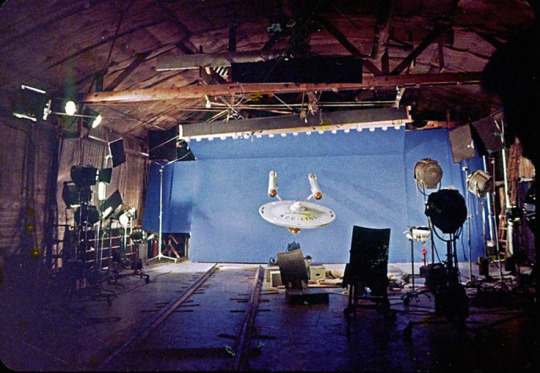
Armed with his script, Roddenberry brought Star Trek to Desilu Productions, (a rather large television production company headed and half-formed by Lucille Ball herself) and met with director of production Herbert F. Solow. Solow saw promise in the concept, and signed a three-year development contract with Roddenberry.
Star Trek moved into the next stage of development. Further drafts were drawn up and the idea that would later become the episode The Cage was revised, until it was shown to CBS as part of the ‘First Look’ deal with Desilu productions. CBS wasn’t impressed with the show, declining to purchase it. They had another ‘space show’ in development that seemed too similar, a show that would become Lost in Space.
However, another company became interested: NBC. In May of 1964, Grant Tinker, the head of the West Coast programming department, commissioned the pilot that would become The Cage (which would later be reworked into the episode The Menagerie). After it was completed, NBC turned it down, claiming that it was ‘too cerebral’, but although this was a mild defeat, Star Trek wasn’t beaten. NBC still showed interest in the concept, and made the highly unusual decision to commission a second pilot: the episode that would become Where No Man Has Gone Before.
With this came quite a few changes.
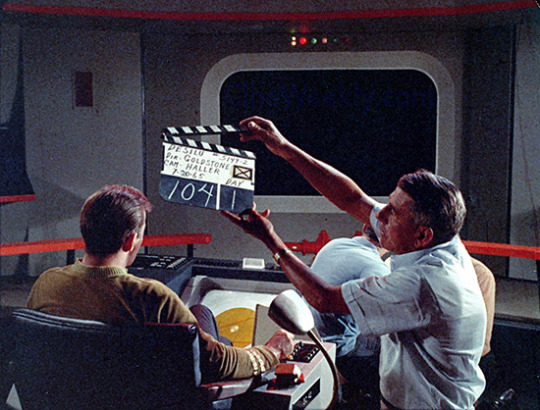
Christopher Pike was scrapped as a character, as was the vast majority of other cast members. Only the character of Spock, as portrayed by Leonard Nimoy, was kept, and of the other cast members, only Majel Barrett stayed, demoted from playing the second-in-command (scrapped due to the unthinkable notion of a woman Commander) to the ship’s nurse, Christine Chapel. With this new pilot came an onslaught of new, more familiar names and faces: William Shatner as Captain Kirk, Chief Engineer Lieutenant Commander Scott played by James Doohan, and Lieutenant Sulu, (originally a physicist in the first episode, but a helmsman afterwards) played by George Takei.
This pilot passed with flying colors, and with that, NBC added Star Trek to their fall lineup for 1966.
Still, there were changes to be made. In this first pilot, the ship’s doctor was Mark Piper, played by Paul Fix. Dr. Leonard McCoy, played by DeForest Kelley, would join the cast when principal filming for the first season began. Also joining the cast was Nichelle Nichols, playing Lieutenant Uhura, and Grace Lee Whitney as Yeoman Rand. (Whitney would depart halfway through the first season, after being on the receiving end of sexual assault from one of the executives of the show, but would later appear in the film series beginning in the 1970s.)
Besides Where No Man Has Gone Before, NBC ordered 15 episodes to start off the show. The first episode of Star Trek, The Man Trap, aired at 8:30 PM on Thursday, September 8th of 1966 as part of NBC’s ‘sneak preview’ time slot, received with mixed feelings. While some papers and reviewers genuinely liked the new show, (such as The Philadelphia Inquirer and the San Francisco Chronicle) others, such as The Boston Globe and The New York Times didn’t. Variety described the show as ‘an incredible and dreary mess of confusion and complexities’, and predicted that it would fail.
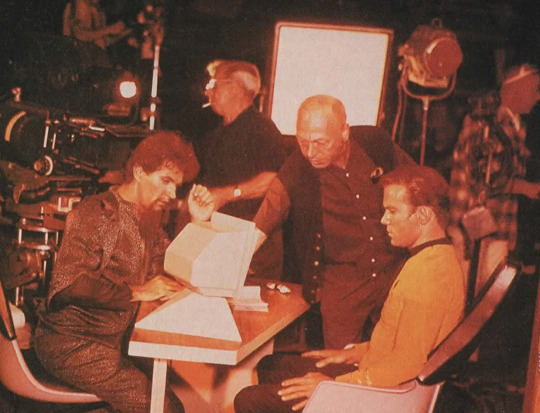
Fighting for position against reruns of previous shows, despite the critics’ warnings, Star Trek won a time slot, and began with decent ratings. However, it didn’t last long. By the end of the first season, Star Trek was sitting at 52nd out of 94 programs.
Star Trek was sinking, fast.
But even then, it wasn’t without its supporters.
The editor of Galaxy Science Fiction, Frederik Pohl, offered up his amazement that Star Trek’s consistency remained good, with no drop in quality after its Tricon winning early episodes. He expressed his fear that the show would be cancelled due to its low ratings, and pleaded with audiences to help save Star Trek, writing letters to prevent its cancellation.
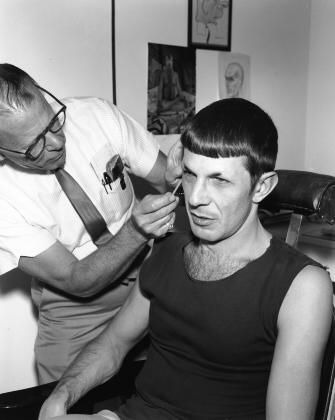
At this time, the only thing that was keeping the show on the air in the first place was the demographics it was reaching. NBC had become interested in the demographics of the shows it was producing in the early 1960s, and by 1967, was using that as part of the decision making as to which shows got dropped.
And something about Star Trek’s demographics interested NBC very much: it had managed to attract ‘quality’ audiences: high income, high educated people (primarily males).
As a result, NBC ordered ten more episodes for the first season, and ordered a second in March of 1967. The network then changed Star Trek’s timeslot, moving it to 8:30 on Friday nights, a timeslot that seemed doomed for failure among the audience that Star Trek had gathered.
The next season, things didn’t seem to be getting any better. It was at this point that the show added on Walter Koenig as Ensign Chekov (as George Takei was working on The Green Berets and was not as available for shooting), although some might have wondered why they would have bothered. The show’s ratings were still dropping. William Shatner, expecting the show to be cancelled, began to prepare for other projects.
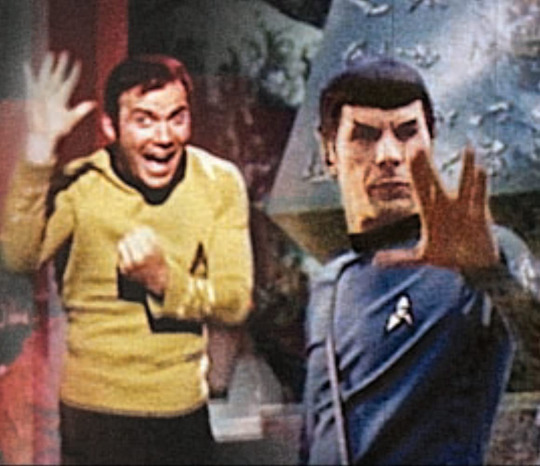
Again, the demographics saved the day.
Roddenberry’s initial concept of adventure alongside morality tales intrigued the audiences Star Trek had attracted. The show had values, values that had to be applied to every situation. The show was sincere, and serious in its exploration of issues like racism, war and peace, human rights, technology, class warfare, and imperialism, far different in tone and content than the other chief sci-fi show at the time: Lost in Space. As a result, the show generated a more interested fanbase, perhaps the first true ‘fanbase’ of any franchise in history. In the end, it was they who saved Star Trek.
By the end of the first season, NBC had received well over 29,000 fan letters. During the second season, Roddenberry began a campaign to persuade fans to write in to NBC, to support the show and save the program. Between December of 1967 and March of 1968, NCB had received nearly 116,000 letters from people who did not want to see Star Trek cancelled. Science fiction conventions, magazines, and newspaper columnists encouraged readers to save what was called ‘the best science-fiction show on the air’.
The fans didn’t stop with letters. Over 200 students of the California Institute of Technology marched to NBC’s studio in Burbank to protest the cancellation of Star Trek in January of 1968, carrying signs that said things like ‘Vulcan Power’. They weren’t alone; other groups of students of MIT and Berkeley did the same thing in New York City and San Francisco.
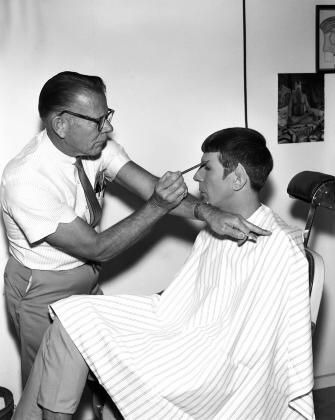
Interestingly, the letters that NBC received were not of the typical ‘fan mail’ quality.
“Much of the mail came from doctors, scientists, teachers, and other professional people, and was for the most part literate–and written on good stationery. And if there is anything a network wants almost as much as a high Nielsen ratings, it is the prestige of a show that appeals to the upper middle class and high-brow audiences.” (Lowry, Cynthia (January 17, 1968). “One Network Goes ‘Unconventional’”. Nashua Telegraph. Associated Press. p. 13)
“The show, according to the 6,000 letters it draws a week (more than any other in television), is watched by scientists, museum curators, psychiatrists, doctors, university professors, and other highbrows. The Smithsonian Institution asked for a print of the show for its archives, the only show so honored.” (Scott, Vernon (February 7, 1968). “Letters Can Save 'Star Trek’”. The Press-Courier. Oxnard, California. United Press International. p. 17.)
After the episode The Omega Glory, on March 1st, 1968, the announcement came:
“And now an announcement of interest to all viewers of Star Trek. We are pleased to tell you that Star Trek will continue to be seen on NBC Television. We know you will be looking forward to seeing the weekly adventure in space on Star Trek.” (“Letters For 'Star Trek’ Hit 114,667”. The Modesto Bee. April 14, 1968. p. 26.)
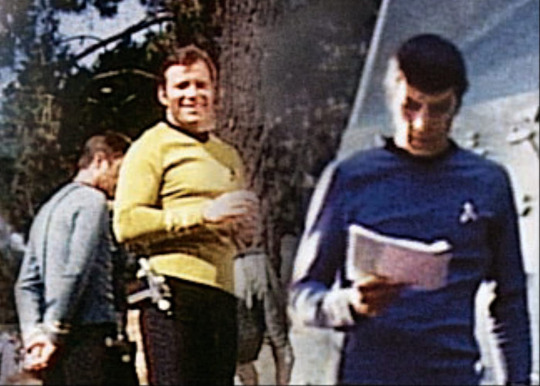
If this was intended to stop the letter writing campaign, it was a dismal failure. A comparable number of letters came in to NBC following this announcement, full of thanks for renewing the show for the third season.
In March of 1968, NBC moved Star Trek to another time slot: 10:00 PM on Fridays, an even worse shot than before. To make matters worse, it was only being seen by 181 out of 210 of NBC’s affiliates. Roddenberry fought the network to move it to a better time, but he was denied. Exhausted, Roddenberry quit working on production of Star Trek, remaining executive producer in name only. The running of the show went to Fred Freiberger, who was with the show as it stood on its last, shaky, legs.
And it was on its last legs.
Star Trek season three was a dying breath, the death-rattle of a show that was being intentionally destroyed by its own network.

To quote Nichelle Nichols:
“While NBC paid lip service to expanding Star Trek’s audience, it [now] slashed our production budget until it was actually 10% lower than it had been in our first season … This is why in the third season you saw fewer outdoor location shots, for example. Top writers, top guest stars, top anything you needed was harder to come by. Thus, Star Trek’s demise became a self-fulfilling prophecy. And I can assure you, that is exactly as it was meant to be.”
It showed.
While I hesitate to call season three of Star Trek a mess, it is difficult to deny that the show was definitely struggling. Episodes dropped in quality, characters became more exaggerated and less ‘true’. Star Trek stopped filming in January of 1969, and after a total run of 79 episodes, the show was cancelled.
As a newspaper columnist advised:
“You Star Trek fans have fought the “good fight,” but the show has been cancelled and there’s nothing to be done now.”
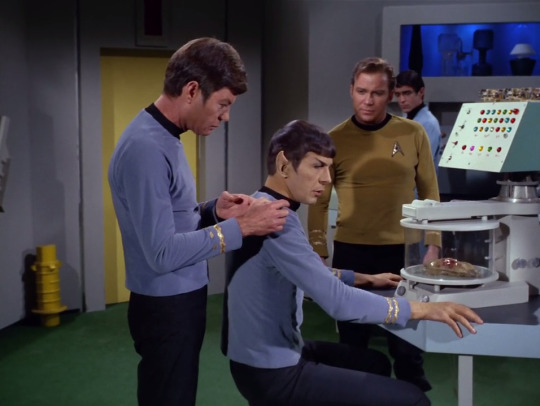
Rather incongruous with the image of the pop-culture giant we know it as today, wouldn’t you think?
So what happened?
As it turns out, Star Trek had enough episodes (thanks to the third season) to enter syndication. Desilu Productions, which at that point had become Paramount, licensed the syndication rights in order to turn a profit, and reruns of Star Trek began airing in late 1969.
In syndication, Star Trek became a cult classic, finding a larger audience on reruns than it had during its original run. The show, which was airing in the afternoons and early evenings, was attracting a young demographic, and, ironically, Star Trek became known as ‘the show that wouldn’t die’. By 1970, Star Trek was boosting Paramount’s ratings, and becoming extremely popular. In January of 1972, over 3,000 fans attended the first Star Trek convention in New York City, kicking off a previously unheard-of trend of organized fan gatherings where they could buy merchandise, meet cast and crew, and screen episodes of the show. These people, coming to be known as ‘trekkies’, took pride in their knowledge and extreme love for this series, which was becoming renowned for being a smart, heartfelt science fiction show that had been cancelled too early.
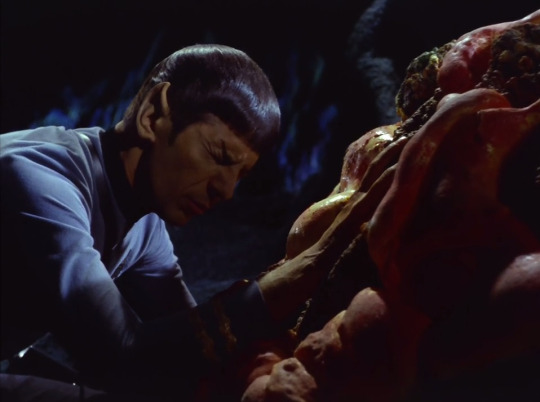
17 years after Star Trek was cancelled and started reruns, Star Trek became the most popular syndicated show of all time. By 1987, Paramount was bringing in $1 million per episode, and by 1994, reruns were still airing in over 90% of the United States of America.
The rest is history.
It has been over fifty years since Gene Roddenberry’s vision of a wagon train to the stars first took flight, and it was a hard battle fought to get as far as it did. Never before had a show garnered the support and devoted love from a fanbase, never had it inspired such huge leaps and bounds in television and fandom alike. Never had a television show meant so much to so many, and continued to do so well past its end.
For a show that struggled through a third season, it seems incredible that Star Trek still holds the weight that it does today. The show that wouldn’t die gained new life beyond the grave, still capturing people’s attention decades after it was cancelled, growing to become one of the best known and best loved television shows ever made.
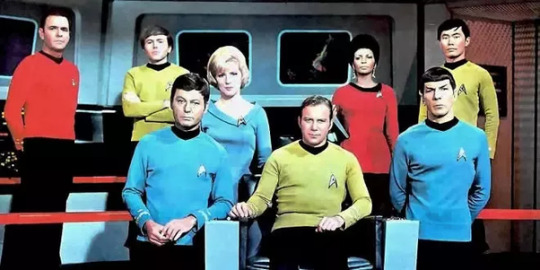
Against all odds, Star Trek lives on, remaining one of the greatest television shows of all time, for very good reason.
Join me for one last article as next time we take one last look at Star Trek in our Final Thoughts. If you have any thoughts, questions, suggestions, recommendations, or just want to say hi, don’t forget to leave an ask! Thank you all so much for reading, and I hope to see you in the next article.
#Star Trek: The Original Series#Star Trek#Television#TV#TV-PG#60s#Drama#Action#Adventure#Science Fiction#Sci-Fi#William Shatner#Leonard Nimoy#DeForest Kelley#James Doohan#Nichelle Nichols#George Takei#Walter Koenig#Majel Barrett#Gene Roddenberry
55 notes
·
View notes
Text
Lately I got some requests about my figures and I know that some of you are collectors of action figures/ dolls or Star Trek fans or both. So I thought a little review is perhaps interesting for you.
Qmx launched their line of Star Trek figures in 2016 to the 50th anniversary of TOS, starting with Kirk and Spock. And this year they released a reissue of both.
Both versions are sold out at QMX but some retailers may still have a few or you can always look for a pre-owned one via eBay or similar platforms.
However one crazy person (me) who already owns the first released Spock could not help herself to get the reissue Spock figure too and realized that there are noticeable differences between the two. So if you consider to get yourself one of the two and are in doubt if you should look for the first release or the second one, I will compare them for you.
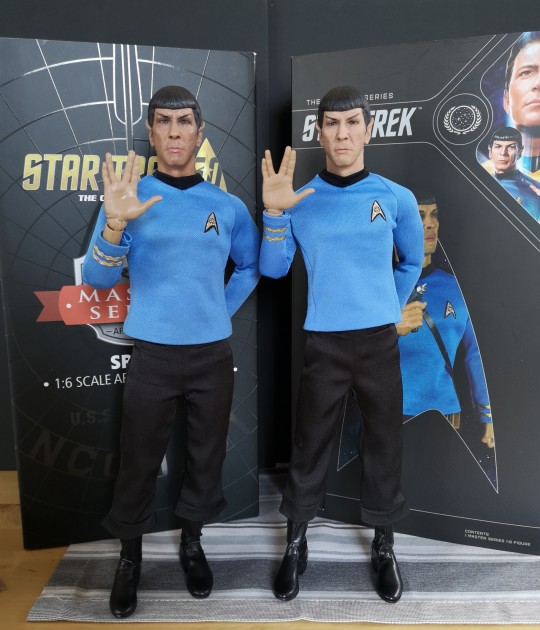
Here are the two gentlemen in front of their boxes, which are also different from each other. On the left, first issue Spock I will call Spock 1 and on the right re-issue Spock, I will call Spock 2.
At first or maybe second glaze you may notice that Spock 2's body is leaner than Spock 1's.
If you think about Spock's famous role model, the gorgeous Leonard Nimoy, the leaner body is probably more accurate.
Regarding the level of articulation and quality, both bodies are quite equal to each other. They are solid and the joints work well. As you can see below and maybe in some of my posts, the many points of articulation make it easy to pose both gentlemen very lifelike.

But before we take a closer look at them, let's have a look at their boxes.
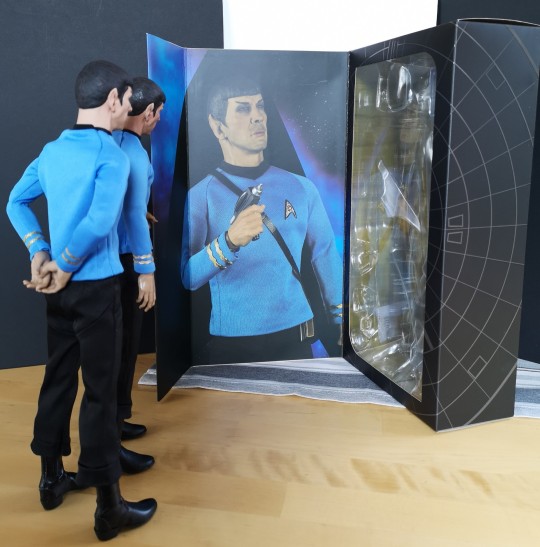
Spock 1's box opens very easily like a book and closes with two magnets very nice and neat. It is not only a nice design IMO but also very friendly if you don't want to damage the box when you unbox the figure.

Spock 2's box slides open and close. As far as I heard, this is the standard for the most action figures, however the risk of damaging the box is higher and the other design is more fancy.
Let's have a look at their uniforms :
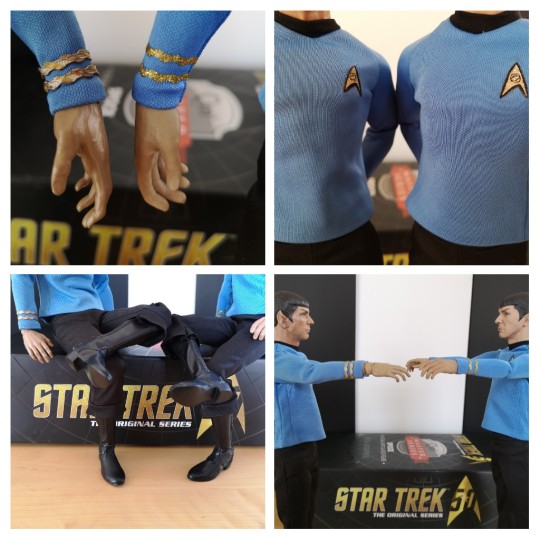
I could not find any difference in the material and color, but I noticed some differences in the tayloring and the insignia.
The shirt of Spock 2 on the right side is more fitted than Spock 1's shirt on the left. Additionally to the actually slightly leaner body of Spock 2, the more loose fitted shirt of Spock 1 is also a reason why he looks from certain angles a bit bulkier than Spock 2.
It seems to me that they really took an effort to improve the sewing pattern of the shirt. The shirt of Spock 2 is not only better fitted, also the sleeves are longer.
That's an advantage for me because I personally like it when my figures joints are covered. If you have a look at Spock 2's sleeves you can see that they are long enough to cover Spock's hand joints even when his arms are reaching out. The sleeves of Spock 1's shirt are shorter and only cover the hand joints when his arms are relaxed.
But apart from the better fit, there are also some important details, the 1st issue version can claim to their advantage. If you look at Spock 1's cuff on the left it looks way more dimensional, detailed and accurate than Spock 2's who looks more like simply painted.
The insignia on the chest of Spock 2 is bigger than Spock 1's insignia and seems a bit out of scale to me. The smaller insignia looks better scaled.
Ok let's go to the bottoms.
The pants are pretty identical. Coming to the boots, I can't see any significant difference too. I heard that some people say the boots of the re-issued version (right) are glossier. To me, they look almost the same.
Let's have a look at the hands and accessories.
The relaxed hands are quite different.

Spock 1's hands on the left seem to me a bit more in scale and naturally shaped while Spock 2's hands seem to be a bit too large, especially the pointing finger seems quite fleshy, compared to the whole figure as well as to the other fingers. Even though, through the camera I noticed that the paint of Spock 2's hands looks more lifelike. This means actually the shape of Spock 1's hands combined with the paint of Spock 2's hands would make the perfect hands.
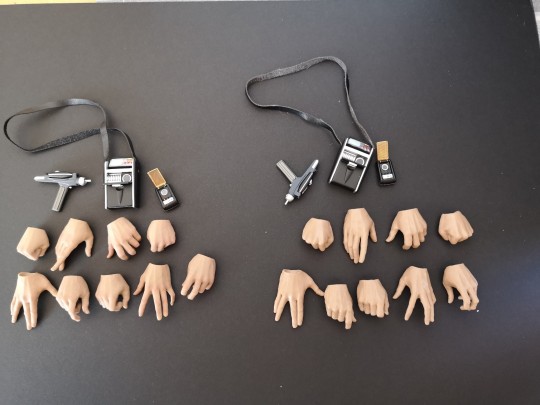
All the other hands are identically shaped in both versions. The difference is the slightly darker skin tone of Spock 1's hands and the more lifelike coloring of Spock 2's hands.
But another difference that I noticed is that the material composition of Spock 2's hands is slightly softer. I would neither say that this is an advantage nor a disadvantage, it is just different. However, it's maybe a bit more easier to put accessories in Spock 2's hands.
The accessories they come with (Phaser, Tricorder and Communicator) are identical both in their looks and functions.
The Communicator can open and close, the Phaser can be separated very easily from a type 1 to a type 2 Phaser and snaps back nice and neat with a magnet that holds everything securely in place. And Spock's Tricorder opens and closes also very nice.
After all the accessories look amazingly realistic, just like in the series and the several hands fit very well with them.
The only thing is that 1st issue Spock was also available as an exclusive version with his famous Vulcan lute. Unfortunately I was too late to get the exclusive version and I'm a bit disappointed that the re-issue is only available without lute.
Now let us finally have a closer look at the skin tone and head sculpts.
The first picture shows Spock 1 in front and profile, the second Spock 2.
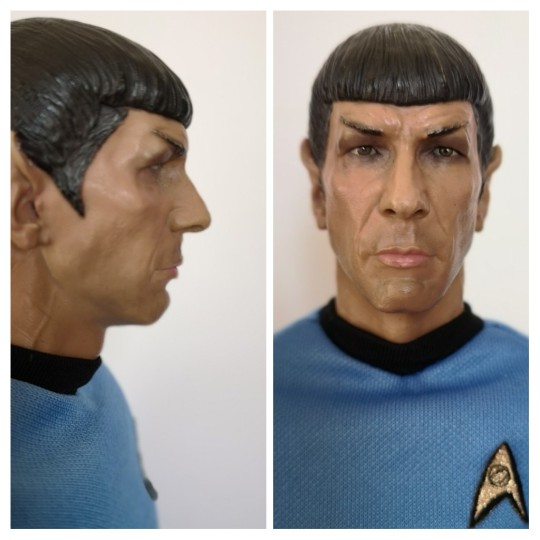
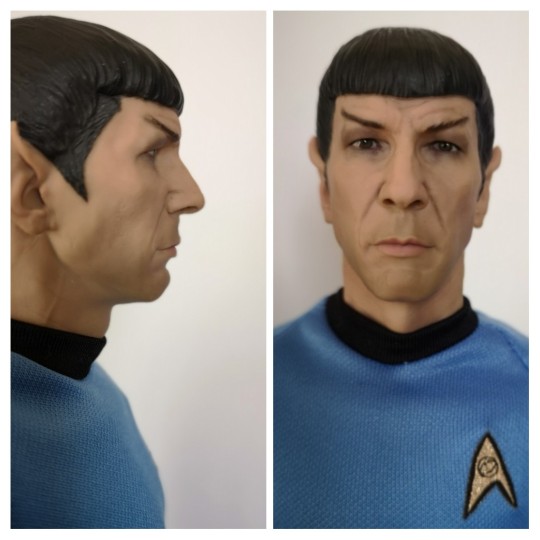
In fact both are adorable because it's impossible to be not adorable when you are a resemblance of Leonard Nimoy.
However when the first issue Spock came out, most of the people who reviewed him remarked that the skin tone is unusually dark for Spock. And some of them also remarked this kind of glossy finish that can be visible mainly through camera, depending on the light and angle.
Spock 2 has a lighter skin tone and his painting is matt. Of course the lighter skin tone is more accurate.
So at first glance you could say that the painting of the re-issue version is better than the painting of the first one because the skin tone is more accurate and no glossy finish. I heard from several people that they prefer the second version.
After all, they are both very close together and the painting of both is terrific. For example the eyes of both look so lifelike, or this dark shading around their chin and cheek area is fantastic and just looks like their facial hair is shining through on the end of a long day of duty at Star Fleet.
But there is one thing why I personally don't agree that Spock 2's painting is better.
This glossy finish of Spock 1 is more visible through camera than in hand. In fact if you compare both in hand, they are very close. But if you'd ask me who of them looks more lifelike and not like a doll, it's Spock 1. I can't exactly explain why, maybe because of this finish that let's him look a bit shiny sometimes. He simply looks more vivid.
But this is my personal perception and other people may have their own opinions.
Honestly I can't say that one is better than the other. It also depends on what is important for you because both have their advantages.
The box of the 1st issue is fancier, more stable and easier to handle.
When it comes to the appearance of both figures:
Spock 1's face looks more vivid, his relaxed hands are more in scale while Spock 2's leaner body and lighter skin tone is more accurate to the role model and the painting of his hands is more lifelike.
When it comes to the clothing:
Spock 1's insignia both on the chest and cuffs looks way better in quality and scale while Spock 2's shirt is better fitted, especially in the sleeves to cover his joints.
And the accessories are identical, except you could get 1st issue exclusive Spock with his vulcan lute.
After all, I love them both. And there is only one thing better than having a little Spock, having two little Spocks...
58 notes
·
View notes
Text
Star Trek Episode 1.11: The Menagerie, Part 1
AKA: Spock Goes Rogue, Shows Vacation Photos
Did you think we were done with the pilots yet? Ha ha ha, no. We will never be done.
You remember how, back in Where No Man Has Gone Before, I mentioned that there was a first pilot that NBC was interested in but didn’t like enough to greenlight the show? That pilot was called The Cage, and was quite different from the eventual show in its design. It was also very different in cast, with Leonard Nimoy and Majel Barrett being the only cast members to stick around for the rest of the show. Nimoy still played Spock, but a much more emotional, earnest Spock, while Barrett played Number One, the second-in-command who was actually much more like Spock, being cool, intelligent, and seemingly emotionless. Instead of Kirk the captain was Christopher Pike, played by Jeffrey Hunter, who made for a much more serious and gloomy kind of leading man.
Now, as mentioned, that pilot didn’t get approved, so they went on with the second pilot, and then with the main show, leaving The Cage to be an interesting what-could-have-been side note in the show’s history, but nothing more than that. Or at least, it would have been, if the show hadn’t run into a problem with production delays while doing the first season, on account of all that time-consuming effects work. To help catch up, they needed an episode that could be completed in much less time than they were usually taking. Come to think of it, didn’t they have an entire story, already shot and edited and everything, just sitting around unused?
And so Roddenberry hit on the idea of re-using the scrapped pilot to fill out season one. It’s an odd example of being a clip show (that is, an episode of a TV show mostly comprised of clips from other episodes) from a production standpoint, but not from an audience one, since they had never seen the old footage before. Of course, the pilot was so different that they couldn’t just drop it in as it was. It was weird enough when they did that with Where No Man Has Gone Before, and at least that one had the same captain. So a framing device had to be invented, something that would allow them to justify showing the pilot in the context of the show. That framing device combined with the longer running time of The Cage—an hour and a bit compared to TOS’s usual fifty minutes—made for two episodes, resulting in the only two-part story in TOS.
Our episode begins with the Enterprise in orbit around a large planet that’s a nice purple color. A view from the planet’s surface shows us a walkway and grassy courtyard between rows of buildings, under a purple sky with a ringed planet on the horizon. A nice change from the planets we’ve seen so far, which have mostly been bleak at best and desolate hellholes no one would want to live in at worst. Well, Miri’s planet was okay. Shame about the plague, though.
Anyway, this planet is clearly quite inhabited, as lots of people in Starfleet uniforms are walking about, including a redshirt woman who pauses and looks around with a rather...confused expression on her face. It kinda looks like she’s just suddenly found herself outside and isn’t entirely sure how she got there.
But a moment later, the thing she was looking for arrives: Kirk, Spock and McCoy beaming down into the courtyard. The woman greets them and says that the commodore is waiting to see them, and wants to know why they suddenly changed course to come visit him. Now it’s Kirk’s turn to be confused, because according to him, they got a message telling them to divert to the base immediately. But the woman says the base sent no such message. Well, that’s a mite strange.
Kirk is soon talking to said commodore, Mendez, who says that no, they definitely didn’t send anything like that to the Enterprise. But Kirk insists that Spock received a message from the former captain of the Enterprise, now-Fleet Commander Pike, and Kirk has rock solid faith in Spock so as far as he’s concerned, if Spock says there was a message, there was a message.
Before Kirk can offer to duel for Spock’s honor, Mendez says that he’s not doubting anyone here, it’s just that it’s impossible that Pike could have sent that message. When Kirk asks why, Mendez is surprised he hasn’t heard since it’s been all over the subspace chatter. Apparently Kirk hasn’t been keeping up with his social media lately. Judging by the commodore’s tone, it’s not happy news.
He takes the three of them upstairs to the medical section, because sure, why not stick a hospital directly on top of your space navy headquarters. On the way, they talk about Pike; Kirk only met him once, but Spock served with him on the Enterprise for eleven years. According to Mendez, Pike was doing an inspection of an old cadet ship when a plate ruptured, exposing the people on the ship to delta rays. Which are a real thing, but probably not one that has much of anything to do with this. Anyway Pike went into the danger zone to rescue all the cadets that were still alive, but judging from the grim warning Mendez gives before he opens the door to Pike’s room, he didn’t come back in great shape.
They enter the room, to see a man sitting with his back towards them. When Mendez addresses him, he slowly turns around, revealing that his chair is in fact a mobility device encasing him up to his shoulders. The little that we can see of Pike himself doesn’t look real good.
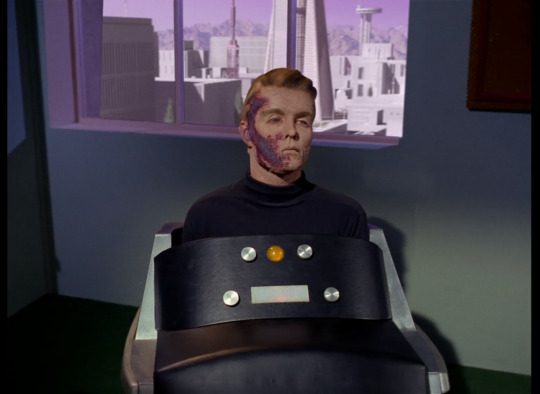
[ID: A man in a hospital room with a large window looking out onto a cityscape. The man is in a kind of pyramidal chair that encases him up to his shoulders, with five round lights arranged on a panel in the front, four silver and one yellow. The man has pale hair, drooping eyelids, bubbled skin on the lower part of his face, and a huge purplish-red burn scar curving from his left temple down to his jaw.]
Kirk, Spock and McCoy look back with muted reactions—which could be called underacting, but I call it sensible, because the last thing you want to do when seeing a person who’s been injured and disfigured is scream about it, that’s not good for anyone’s mental health. Mendez goes over to Pike and says hey, you remember these guys, they wanted to come see you. In response, the yellow light on Pike’s chair flashes twice. Mendez says two flashes mean no. So, he doesn’t remember them, or he doesn’t want to see them? Mendez seems to think it’s the second one, because he asks if Pike won’t make an exception, but he only gets another no. Looks like they’ll have to leave. Kirk asks if there’s anything he can do for Pike, but he also gets a no.
As they turn to leave, though, Spock asks Pike if he can stay for a moment. The chair light flashes once for yes, so the other three exit, leaving Spock alone with his former captain.
Spock says that Pike knows why he’s come. It’s an awkward conversation. “It’s only six days away at maximum warp, and I have it well planned.” Two flashes. “I have never disobeyed your orders before, Captain, but this time, I must.” Two flashes. “I know. I know it is treachery, and it’s mutiny. But I must do this.” Two flashes. “I have no choice.” Two flashes. One suspects that if there was a “goddammit, I said NO” button, Pike would be using it.
That’s not Jeffrey Hunter playing Pike here, incidentally—he declined to come back for the second pilot after the first one didn’t get picked up, and was way too expensive and busy for them to hire him back just to get covered in makeup and sit motionless in a pyramid chair. So the older Pike was played by Sean Kenney, suffering through what had to be one of the most boring acting jobs ever.
After the titles, night has fallen on the purple planet, and still Kirk and Mendez are arguing. Kirk says that Spock claiming to have received a message is all the proof he needs, but as the commodore points out, the record floppy discs tapes show no sign of that message being sent. Kirk suggests the tapes could have been altered, but Mendez says fact is that Pike could not have sent that message and Spock’s the only one who seems to have seen it anyway. Kirk points out that if Spock wanted to see Pike there’d be no need to fake a message, he could have just asked for leave. “WELL THAT’S TRUE OF COURSE!” Mendez yells, and then kind of peters out awkwardly.
The question is, if the Enterprise was nefariously diverted to the base by someone, why? There was nothing urgent going on where they were that anyone would want to get them away from. Mendez calls down to the computer lab to see if there’s any way that message could possibly have been sent from the base, but the guy on duty says that no, they’ve checked and double-checked everything possible. Mendez tells him to start checking the impossible. Dammit, why do these Starfleet types keep saying that? What is anyone supposed to do with that order? “Well, I guess we’ll go look for unicorns in the server room.”
As the computer chief gets up to go set leprechaun traps or whatever, Spock enters from the door behind him. We can tell he's up to no good because he's in stealth mode, creeping suspiciously past a partition in the back of the room and coming up behind the computer guy, who gets nerve-pinched before he even knows what's up. Spock leaves him on the floor and sets to work tampering with one of the computers. Hands-on hacking, that's how they did it back in the day.
Upstairs...downstairs? Adjacent? In another building? Wherever the commodore's office is relative to the computer lab, the redshirt woman from earlier has stopped by. Mendez introduces her to Kirk as Ms. Piper. (She's a civilian? I guess? She wears a uniform but has no rank on her sleeves.) Piper says that she recognized Kirk immediately because a mutual friend described him to her—yet another one of Kirk's old flames, evidently, judging by the way he reacts. Before we can go too far down that old road again, though, Mendez nudges Piper to make her report.
Piper says that their investigation turned up very little, except that Spock served with Pike for several years and was very loyal to him, which we already knew. Kirk butts in to say that a Vulcan “can no more be disloyal than he can exist without breathing” which applies both to Spock’s former commander and his present one. This strikes me as a rather odd thing to say. What do you mean he can't be disloyal? Can Vulcans not dislike or disagree with people that they serve under? Do they just become bound to obey anyone with a higher rank than them? Because that has all kinds of unpleasant implications. It could be that their culture simply places a very high priority on loyalty, but Kirk makes it sound like it's built into them. But then I guess Kirk is a bit on the defensive right now and he might be overstating things. Or he could just be wrong.
Anyway, Piper points out that look, they have to consider everything, and the results on the unicorns haven't come back yet. What they know for sure is that Pike couldn't have sent that message because his condition means he's under constant observation. Mendez says that Pike's chair is built to respond to his brain waves, so he can move it around a little or flash the light, but that's all he can do.
This is something that has always bothered me about this episode, to be honest. It seems weird that they're able to build Pike a chair that can respond to his brain waves but not so well that he can any do more than scoot around a little, but you know what—fine. Let's take it as a given that this is indeed the limit of the technology and medicine of the setting. But no one could think of any way that you could use that little bit that he can do to communicate any better than just yes or no? Really? He can make a light flash—y'all ever hear of morse code, aka a whole system of communication that requires nothing more than a light that can turn on and off? What about a letter board with lights so he can spell out words? If he can mentally activate a light, could he not mentally activate buttons for a text-to-speech device? Or at least a small set of pre-recorded messages? I mean, we have paralyzed patients in real life, right now, who can communicate better than poor Pike even though we have way less advanced technology, because we put some thought into how best to use the technology we do have. At least it's not like they also have people with telepathic powers in this setting—OH WAIT. THEY DO.
At any rate, Mendez reiterates that Pike couldn't have even asked for the message to be sent; his mind is fine and active, but his body can't really do anything anymore, and because everyone in this dang hospital is terrible at their jobs he can't communicate more than yes or no.
In the computer lab, Spock is playing with some wires to make a voice saying 'starbase operations' speed up and slow down. This would seem to be part of the process to synthesize a voice giving new orders to the Enterprise. That, or he was just doing it for fun. On the Enterprise Uhura receives the fake message, saying that they're getting new orders which are top secret so they're going to be fed directly into the ship's computer. This strikes both Uhura and the random guy who I guess is in charge at the moment—a goldshirt named Hansen; don't get attached he won't stick around-- as odd, so they request confirmation.
Before Spock can send that confirmation, he's interrupted by a guy coming in and demanding to know what he's doing in a secured area. He's tampering with the computers, what does it look like he's doing? Spock says he has clearance, but the guy doesn't buy it, and tries to pull him away from the computer. This results in a brief shoving match between the two, like two siblings fighting over the X-Box, before Spock remembers that oh yeah, he can do that thing that makes people go unconscious and stop bothering him.
With that problem temporarily solved, Spock is able to give Uhura confirmation by way of a convenient tape that has a recording of Kirk saying, “You have confirmation” on it. Then he puts in another one that tells them to direct all messages to Spock. Oh, well that's handy.
Spock then tells them that their course for this mission will be computed and laid in automatically, so even the helmsmen won't know where they're going. Also this is top secret so don't discuss it with anyone. Also we're leaving in an hour, so make sure you go to the bathroom beforehand.
Meanwhile, Kirk is sitting by a monitor watching Pike in his room. And y'know, while we're on the subject of Pike here, you'd really expect a completely paralyzed patient under permanent full-time care to have a room that was actually designed to fit their needs as well as possible, wouldn't you? But no, they just crammed his chair into a regular hospital room, complete with a bed taking up half the space. That's just mean. “Here's a bed, you can never use it again, but you'll have to look at constantly!” Maybe that's why Pike is currently facing the camera and flashing 'no' over and over.
McCoy comes in and says he's tried questioning Pike, who's apparently really agitated. Then he goes on a passionate rant about what good is medicine anyway when they can't use it to help this man, trapped with a perfectly functional brain but no way to reach out to people. It's very heartfelt; you sort of get the impression that DeForest Kelley knew he didn't have much to do in this whole story but damn if he wasn't going to do the most he could with what he did have.
Kirk isn't impressed, though; in fact he just keeps staring at the monitor with no sign that he heard McCoy at all. The two of them question what Pike is saying 'no' to; it's an answer but they have no hope of guessing the correct question. But Kirk seems less focused on the plight of Pike and more on this whole mystery about the message. Either someone at the base sent them that message, or someone on the ship lied about receiving it—and he's starting to wonder if, in fact, that someone was Spock.
McCoy doesn't buy that at all; even regardless of how well they know Spock, he says, Vulcans can't lie. Later evidence throughout the show points more towards “Vulcans really want people to think they can't lie” but McCoy doesn't know that yet. And while, yes, Spock is half-human, he so fully identifies as Vulcan that McCoy doesn't see any chance of him acting or thinking like a human; he'd be ashamed to do so.
But Kirk's getting riled up. Someone is messing with his ship and he really hates it when that happens. At this point everyone is under suspicion as far as he's concerned—he'd even suspect McCoy if he thought McCoy knew how to fake a message like that. McCoy is perfectly willing to admit that he could absolutely run off and do some wild bullshit if the mood struck him, but he still insists that Spock wouldn't.
The argument has just about escalated into a shouting match, but it's abruptly derailed by a message on the intercom telling McCoy to report to the transporter. Apparently he's needed on the Enterprise because of a medical emergency, but the guy on the line doesn't know what it is, just that they need McCoy for it. McCoy seems less than impressed by this—reasonably enough, considering that apparently someone managed to get themselves so injured the remaining medical staff can't deal with it while in a safe orbit--but he heads off, promising to let Kirk know what's up when he finds out.
Some indeterminate time later, Mendez is showing Kirk a sealed dossier with TALOS IV—TOP SECRET FOR EYES OF STARFLEET COMMAND ONLY on the front. Mendez asks Kirk what he knows about Talos 4, and Kirk says he only knows what everyone knows—General Order Seven forbids any ship from ever going there for any reason. In fact, Starfleet is so serious about this that it warrants the death penalty—the only one there is left anymore, apparently, but Mendez says that only Fleet Command knows why. Hold on a minute, can Starfleet really enforce the death penalty? They're not actually the government, they're like...the space navy. Do they really have that much power? It'd really suck if we as a society decided to abolish the death penalty, only for Starfleet to come in and be like, “Yeah, we just need it for this one thing though. We're not gonna tell you what it is. Just trust us.”
Apparently this whole business is so secret that even the super-duper secret file Kirk has in front of him doesn't explain what's up. Mendez unseals it and we see the terrible contents.
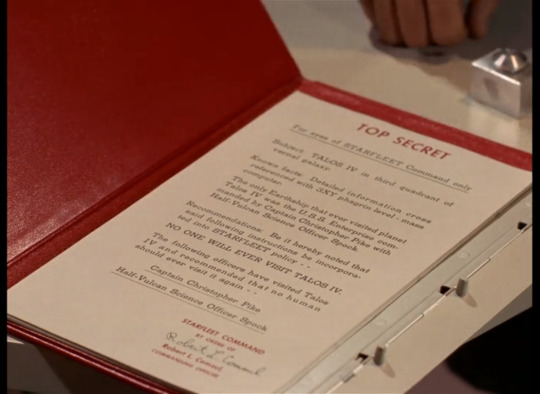
[ID: A paper inside a red folder which reads: TOP SECRET. For eyes of STARFLEET Command only. Subject: TALOS IV in third quadrant of vernal galaxy. Known facts: Detailed information cross referenced with 3XY phagrin level-mass computer. The only Earthship that ever visited planet Talos IV was the U.S.S. Enterprise commanded by Captain Christopher Pike with Half-Vulcan Science Officer Spock. Recommendations: Be it hereby noted that said following instructions be incorporated into STARFLEET policy--NO ONE WILL EVER VISIT TALOS IV. The following officers have visited Talos IV and recommended that no human should ever visit it again--Captain Christopher Pike--Half-Vulcan Science Officer Spock.]
And that's it. It gives information that's relevant in the context of the episode, but it's difficult to see why those specific facts would be in any way useful to anyone else. It's basically Exposition: The File. Also, what's with the weird obsession with pointing out that Spock is half-Vulcan? Is that really so relevant that it needs to be mentioned constantly in case anyone forgets? Why is he so important to this document anyway if he was just the Science Officer at the time? Spock is important on Kirk's Enterprise because he's the Science Officer and the First Officer. Being First Officer is the bit that makes him right below the captain in the chain of command, just being Science Officer doesn't make him really relevant to big Starfleet policy decisions.
Kirk and Mendez briefly restate the important bits of the document, for the sake of the audience that didn't have highly detailed screens and a pause button, but before they can get into it they're interrupted by a shout from Piper. She'd been watching—well, kind of staring blankly at, to be honest—the exciting live video feed of Pike's quarters, looked away for just a moment, and when she looked back Pike was gone. Evidently he only moves when you’re not looking at him, like a Weeping Angel or Watson in that one Sherlock Holmes game.
While Kirk and Mendez sit there not emoting about this, a message comes in on Mendez's terminal. The Enterprise is leaving orbit, and refusing to acknowledge the base. That's significant enough news for Kirk to turn grimly to the camera before commercial.
Up on the Enterprise, Hansen remarks that it's odd to be heading out with no navigator at the helm, but Spock tells him the Enterprise knows where it's going. I guess Sulu is just gonna get to sleep in today. Come to think of it, one wonders why they need navigators on duty all the time if the computer can do such a good job of it.
Uhura says that they're being hailed, but Spock tells her to keep maintaining radio silence. Then he makes an announcement over the PA: their mission is secret, he's in charge, and Kirk was assigned medical rest leave until they get back. Now everybody go about your business. Nothing to see here, carry on, carry on.
Of course, Spock can tell most people on the ship not to question his orders, but there's one person undeterred by any secret mission or Starfleet orders, and certainly not deterred by Spock: McCoy, who's just come up on the bridge demanding to know what the frell is going on around here. He can't find the source of that emergency that called him back up to the ship, and now Spock is saying Kirk needs medical rest leave? What is this nonsense?
Spock calmly admits that there are some things McCoy hasn't been told, and asks the doctor to come with him. The two of them go to...uh...someone's room, where, much to McCoy's surprise and consternation, Pike is hanging out in the corner, his light still flashing 'no'. Before McCoy can really get into a good rant, Spock plays him a message from Kirk saying that McCoy is to take care of Pike, ask him no questions, and obey Spock's orders. We've still yet to get an explanation as to how Spock is managing to make these fake recordings, anyway. I guess audio editing software has just come a long way by this point.
I'm really not sure what McCoy is supposed to be doing for Pike anyway. You'd expect a patient in his condition to need considerable life support, but we never see any more of him than his head sticking out of that chair, and there was no sign of any other medical equipment in his hospital room. I guess his chair just takes care of all his biological functions? If so I don't know if McCoy can do a whole lot more than maybe put a blanket over him or something.
Spock leaves McCoy (who's got a 'I may be quiet right now but you better believe I haven't given this one up yet' look on his face) to ponder this and goes back up to the bridge, where Hansen tells him that there's an object following them that's suspiciously the size of a Starfleet shuttlecraft. Which makes this the first appearance, in airing order, of said shuttlecrafts, though it’ll be a bit longer before we see any of the actual Enterprise ones. Hansen wants to know if they should turn around or at least stop so the shuttlecraft can catch up to them, but Spock says no, full speed ahead and no contact.
So the Enterprise trundles on through space, followed by a shuttlecraft occupied by Kirk and Mendez. Mendez is trying to make contact with the Enterprise, ordering them to respond to his message, but he's having no luck. By now they're sure that Spock is indeed heading to Talos 4, but they've got no chance of catching up to the bigger ship, and if they go any further they won't have enough fuel to get back to the base.
Spock seems to be thinking along the same lines, because we see him talking to the ship's computer, first asking it to confirm that the object following them is a shuttlecraft, and then asking how long the craft has before it has to return to base. The computer tells him that the craft is already past the point of no return. I'm not sure how it knows this, but the Enterprise computer works in mysterious ways.
Sure enough, the little shuttlecraft that could(n't) soon runs out of fuel, leaving them to coast. Which they will presumably do forever or until they bump into something, because that's how space works, but probably we shouldn't think too much about how space works while watching Star Trek. Kirk angrily stalks around the cabin and tells Mendez that the commodore should never have come anyway, but Mendez cheerfully tells him that he's high-ranking enough that he can do what he wants.
They've got life support for now, at least, but only two hours until the oxygen runs out. Kirk glumly ruminates that he almost hopes that the Enterprise doesn't come back for them because if they catch up to Spock he'll be court-martialed into the next galaxy. Or, if he makes it to Talos 4, executed. I guess the punishment for going to Talos 4 is Federation-wide, even though it's hard to see the Vulcans being onboard with the whole death penalty thing. It's a bit difficult to disentangle Starfleet, the Federation, and the individual planets in the Federation at the best of times but this episode is really making things confusing.
Mendez wonders what reason Spock could have for taking Pike back to Talos 4—according to the reports, the planet has nothing of benefit to offer. Kirk says there Spock has to have a logical reason, but Mendez says maybe he just went mad. You know, like people just do from time to time.
Spock, for his part, seems to still be quite calm and rational about all this, but McCoy's doing his best to change that, standing on the bridge and loudly wondering just who could be in that mysterious shuttlecraft. As usual Spock ignores him; he's busy with locking a tractor beam onto the shuttlecraft, then having the Enterprise come to a halt so they can pick it up.
Then he tells Security to send an armed team to the bridge, tells the transporter room to get ready to beam Kirk aboard, and puts Hansen in command. Which seems odd—well, for the obvious reason, but also because I'm pretty sure there are more people in the chain of command between the First Officer and a random goldshirt we've never seen before or since. Heck, where's Scotty? He's high-ranking enough to take command if both Kirk and Spock are away. Did they leave him behind too? Even Hansen seems confused by this. Poor Hansen—he's having a very confusing day.
Spock then turns to McCoy and says that, since McCoy is the senior officer present, Spock is presenting himself to the good doctor for arrest. This absolutely blindsides McCoy, who had probably been wondering if Spock had finally called a security team on him to make him go away. Spock confesses that he never received orders to take command and has in fact committed mutiny, then waits calmly as the security team arrives. McCoy, for his part, is completely flummoxed, and just kind of stands there in shock for a moment until Spock gently reminds him that he's supposed to be doing something.
This is but a little moment, but a nice bit of characterization. I think McCoy, out of all the main cast, is the one that feels least connected to the identity of being a Starfleet officer. He's a doctor, dammit, and he's fine with fussing at people or even pulling rank in that capacity because it comes out of the perspective of being their doctor. That's how he identifies himself—being in Starfleet is just kind of something that happened to him. But this is asking him to act as a ranking officer, to exert command over someone else in an entirely non-medical sense, and he is clearly neither familiar nor comfortable with that role. I don't think he would be regardless of who he was dealing with here, but the fact that it's Spock he's being asked to bring the hammer down on just makes it even worse. Sure, McCoy will badger and pester and tease Spock, and just this far into the series we haven't seen their friendship develop much, but the fact that McCoy is stunned and dismayed rather than being gleeful over the opportunity to do something like this pretty clearly shows that he does respect Spock and has no desire to see him genuinely brought down.
But eventually McCoy manages to tell the security team that Spock is under arrest—and then, adorably, has to ask Spock himself if confinement to quarters will be enough. Spock says that will be fine since he's not planning on making trouble, and calmly walks away with the redshirts.
Meanwhile Kirk is telling Scotty to beam the two of them up and stick the shuttlecraft in the hanger. Wait, so Scotty is here. I guess he just couldn't be bothered to walk up to the bridge to be in command for the five minutes or so until Kirk got back?
Hansen clearly wants none of this either; Kirk has barely stepped off the platform before Hansen is rushing forward to transfer command back to him. Kirk takes it back and asks where Spock is, and Hansen says he's been confined to quarters. Mendez is shocked that he was only confined to quarters. Look, Mendez, everyone's doing the best they can right now, okay, it's been a very hard day.
Before they can start getting into that, though, Uhura calls down to say that the engines are coming back on. Kirk says to belay that and stop the ship, only to be informed that the ship is now under computer control that they can't disengage from. Scotty is outraged by this and storms off to go yell at the computer until it behaves. Kirk tries to override the computer controls himself, but the computer says that it can't disengage until they reach Talos 4, and any attempt to do so will screw up the ship's life support.
So it looks like they're stuck for the long haul as the ship carries on towards Talos 4. In the meantime, they're going to hold a preliminary hearing for Spock. As a way to kill time on long trips I generally prefer a good podcast playlist, but you guys do you.
The hearing convenes, with Kirk and Mendez sitting in judgment, accompanied by a couple of security guards and a redshirt with a computer who I guess is gonna be the stenographer or whatever. Kirk begins by reminding Spock that he has the right to representation, but Spock says he waives that right. In fact, he's waiving his right to the hearing itself, and wants to go straight to a court-martial. Kirk is like “What? No.” When pressed to provide an actual reason, he says that a court-martial for mutiny requires three officers of command rank, and since Scotty is presumably still busy swearing at the computer they've only got Kirk and Mendez. But Spock points out that actually, there is another such officer aboard: Pike. Because despite his condition, Pike is still technically on active duty. Mendez says they “didn't have the heart to retire him.” Oh, oh you didn't have the heart. Well I'm sure that's a great comfort to the man. He's stuck in a mobile iron lung for the rest of his life and can only say yes or no because no one could be arsed to find a better way for him to communicate, but at least his name is still on some paperwork somewhere.
But Spock's rules-lawyering checks out, so it looks like they'll have to hold a court martial after all. By Starfleet regulations a court-martial is required to be spiffier than just a hearing, so they move to a different but nearly identical room, put dress uniforms on, and stick a couple of flags in the background. Also they've dug out a large bell from somewhere so Mendez can hit it with a mallet at important moments. Scotty and McCoy are now in attendance as well, though for some reason only McCoy had to wear the dress shirt. I don’t really know why they brought those two, honestly; I mean I always like having them around but they really have nothing to do except sit there and look glum. And, of course, Pike has been brought in too. They didn’t dress him up, though.
Spock is still waiving his counsel and has pled guilty. Well, that sorts that out, I guess. Mendez points out that if the vessel makes it all the way to the Talos system there will be another charge brought against him that carries the death penalty, which Spock is aware of and doesn't seem real bothered about.
Mendez demands to know why Spock is doing all this, and Spock responds by requesting the use of the room's monitor screen so he can show evidence to explain himself. Maybe he's prepared a powerpoint? No, evidently, for the screen shows video, a shot of the Enterprise itself that sweeps in to focus on the bridge. But not the bridge we know—this is the Enterprise thirteen years ago, Spock explains, under the command of Captain Pike. The set design is clearly different, though still reminiscent of the one we know, and the crew are wearing heavier shirts similar to the ones from Where No Man Has Gone Before.
On the screen, we see Spock telling Pike that something is headed towards them, but before we can find out what it is, Kirk turns the screen off and asks Pike if that guy on the screen was really him. Pike says yes. You can understand Kirk’s confusion though; young Pike and old Pike look so unalike it’s almost like they were played by two different actors or something. Kirk says this is impossible—ships don't make record tapes in that much detail. Presumably they also don't usually make record tapes that include shots from outside the ship, unless all starships are constantly being followed by a camera ship like on Deadliest Catch. They probably also don’t make record tapes with multiple camera angles and close-ups at appropriately dramatic moments. So what are they looking at? Spock says he can't tell them yet, and Pike confirms that this isn't a record tape from that voyage.
Mendez says this evidence is automatically invalid since they have no idea what it is or what it came from, but Kirk says he wants to see more. And no, it doesn't have anything to do with Spock being his friend! Kirk is totally impartial in this matter! Really!
So they turn the screen back on and resume watching. Spock explains that they were on patrol at the time when they detected something coming toward the ship at the speed of light. Not another cube, hopefully. Pike declines to engage defensive maneuvers and proceeds full speed ahead, and they soon find out what the approaching thing is: a radio wave. You guys can't tell the difference between a radio wave and a physical object coming at you? I hope they upgraded the Enterprise's sensors sometime in the ensuing thirteen years.
Specifically, the radio wave is an old distress signal (there's a lot of those bouncing around the galaxy). It was a survey ship, apparently, the S.S. Columbia, that got in trouble and had to make a forced landing—somewhere in the Talos star system. This was eighteen years ago, which is how long it took their distress signal to carry this far. Not terribly useful as a distress signal, was it.
Spock exposits—loudly—that the Talos star system is unexplored, but they know it has eleven planets, and the fourth one is Class M, meaning it has an oxygen atmosphere and it would be possible for the survey crew to have survived there—if they made it through the crash landing. But with no guarantee of survivors Pike isn't going to divert course to check it out, because there are injured crewmen aboard so they have a pressing need to make it to the colony they're headed for. He gives the conn to his first officer, a dark-haired woman working the helm, and leaves the bridge.
Pike heads through the corridors, inexplicably passing by a man and woman in modern-looking civilian clothing.
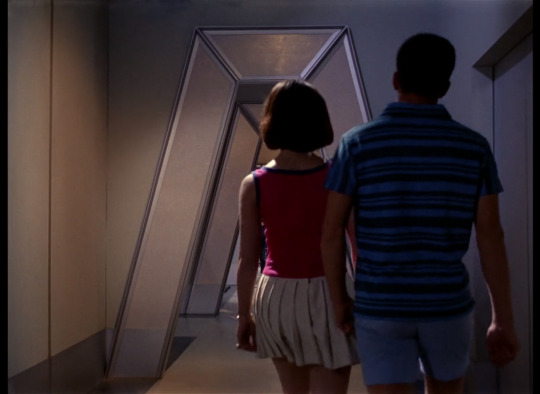
[ID: A man and a woman, seen from behind, walking through the Enterprise corridors. The woman is wearing a pink sleeveless shirt with a white pleated skirt, and the man is wearing a blue and black striped t-shirt with blue shorts.]
uh
He enters his quarters, calls up one Doctor Boyce and tells him to come by, and then flops moodily onto the bed. One thing hasn't changed in thirteen years—the total lack of blankets in the Enterprise quarters. Everyone just sleeps on a bare mattress. In their boots.
All of about five seconds after being called, the doctor comes in, carrying a rectangular case with him. Pike protests that there's nothing wrong with him, but Boyce has a different kind of medicine in mind, and proceeds to put together a martini from the contents of the case. He's reckoned that Pike has more on his mind than just getting the doctor's opinion about the distress signal in his log, and quips that “sometimes a man will tell his bartender things he'll never tell his doctor.”
You can definitely see ideas here that would eventually evolve into the character of our own good Doctor McCoy—the ship's doctor who is also a personal confidant for the captain, with a liking for serving drinks and philosophizing. But, while I'll grant it's hard to tell since we don't see all that much of him, Boyce feels distinctly less interesting. He's more passive and neutral, less emotional and...well, he's just not DeForest Kelley, dammit.
Boyce coaxes Pike into talking about what's really bothering him: a fight on Rigel 7 that killed three crewmen and wounded seven others, discussed in just enough detail to tantalize the prospective network. Pike is beating himself up for letting the whole thing happen, though Boyce doesn’t think he could have done anything differently. He's tired of this whole bloody captain thing anyway, tired of having to make dangerous calls and be responsible for life and death. He's so tired he's thinking about resigning altogether, maybe going back home and hanging out with his horses. When Boyce expresses disdain for such a boring life, Pike fires back that he doesn't have to do that, he could—he could become an Orion trader! Boyce is incredulous of the idea of Pike “dealing in green animal women slaves” and Pike says the point is that being a captain isn't the only life available. Um—sorry, Pike, just, uh, hold up, go back a minute there—did you just put out slave trader as a possible career option? We just, uh, we just not gonna talk about that? Just a little?
But Boyce seems less concerned with the ethics of Pike's potential career choices and more with the fact that he doesn't see Pike being happy as anything but a starship captain. “A man either lives life as it happens to him, meets it head on and licks it,” he says, “or he turns his back on it and starts to wither away.” That’s right, life is just a bunch of things that happen to you and if you don’t like it you die. Real men don’t make choices about their future! That’s quitting talk!
Pike comments that he’s starting to talk more like a doctor than a bartender, to which Boyce replies that they both get the same kinds of customers: “the living...and the dying.” Well that’s fair enough for doctors, but if you’re a bartender and your customers are dying I feel like you’re doing your job very wrong.
Mercifully this dreary conversation is interrupted by a call from Spock: they’ve gotten another message, a follow-up to the distress signal saying that there are indeed crash survivors on Talos 4. We cut to the bridge, where a computer prints out a paper copy of the message for a crewman to read out loud. Wow, this future technology really is something. The message says that there are survivors, the planet is habitable, and they can get food and water, but unless...unleeeeeess? Unleeeeess? We don’t know, because the message stops there.
This is enough to convince Pike that they’re going to check out Talos 4 for survivors. Which is a bit odd: one would presume the second message is also about eighteen years old (because if they could send a quicker message why not do that in the first place) which means either there’s no survivors left at this point or if there are they’ve survived almost two decades so they’ll probably be okay for a few more days, whereas the injured crewman on the Enterprise might not be. But who am I to question the judgment of a Starfleet captain.
As the helmsmen lay in the course, the camera draws back from the scene and into the trial room. Mendez, it seems, has had enough. He turns the screen off and tells Spock alright, very good, very creative, don’t know how you did it--but this isn’t a theater, it’s a court of space law, which is like regular law but in space. Spock calls in Pike for backup, asking him to confirm that they’re watching events that really happened rather than something Spock made up, which Pike does. It’s the real deal, Spock says, and if they’re not convinced by the time they’ve watched the whole thing then he’ll unlock the computer control and turn the ship around.
Mendez is outraged by this and is ready to end the trial here and now. Kirk still wants to hear the rest of the story. It’s up to Pike to be the tiebreaker. He sides with Kirk, naturally, since after all we’ve still got a lot of footage left to use.
With that pointless bit of padding over, the story continues. The Enterprise of the past has arrived at Talos 4, and preliminary studies indicate that the planet is indeed safe for human life. A helmsman spots reflections on the planet’s surface that look like metal, possibly the remains of a spaceship. Pike assembles a landing party, including Spock and the helmsman, but not the first officer, who he wants to stay behind because they need an experienced officer on the ship in case things go bad on the planet. They can’t afford to lost their second most important person, after all! Only the first most important person can take that risk.
The landing party gets ready to head out, putting on heavy jackets and shoulder holsters for gear first, because this was before Starfleet instituted the Just Go Down In Your Shirts Or Whatever, It’ll Probably Be Fine policy. They beam down into a dusty landscape filled with rocks, with the only sign of life being a few grim-looking plants. Mountains loom in the distance under a greenish sky filled with thick black clouds. It’s not a welcoming kind of place.
Phasers at the ready, the group moves through the rocks. From this perspective you can see that Spock is limping, meant to be an indication that he was also injured during whatever happened on Rigel 7, but it’s never elaborated on in the episode. They hear a strange humming sound and follow it to its source, a plant with bright blue vibrating leaves. Pike and Spock are intrigued by it, and Spock actually grins with enjoyment, a weird thing to see. It’s a remnant of the different writing for the original pilot and how Nimoy’s character choices differed when he was playing against the more serious Pike versus when he was playing against Kirk, but since they wound up using the footage it’s canon now and we just gotta deal with that.
Leaf enjoyment over, the party goes back to wandering through the canyon until, what ho, there are some survivors over there. They’ve got a base camp among the rocks made of scavenged materials and spaceship parts. There’s quite a few survivors in the camp, all older men (white, natch) wearing extremely ragged clothing. They’re stunned and overjoyed to see the Enterprise crew, and ask if Earth is alright, evidently not trusting in humanity to not destroy the planet when left alone for eighteen years. Which, I mean, that’s fair.
The conversation comes to a sudden halt when the crewmen catch sight of an incredibly shocking phenomenon: a woman. Unlike the other survivors she’s young, and while her clothes are still ragged, they’re ragged in a suspiciously tight and skimpy way instead of the random shreds everyone else is dealing with. Also, since she’s been living in a makeshift shipwreck colony on an inhospitable planet for almost two decades, naturally she’s wearing makeup and her skin and hair are pristine. And she walks seductively to boot.

[ID: A survivor’s camp made from scavenged equipment, with a few survivors in worn clothing standing around. In the center of the image is a white woman wearing a ripped, sleeveless blue shirt with a very low neckline and a brown skirt made of some kind of scavenged fabric. She has short, puffy blonde hair and is looking at the camera with a somewhat dazed expression.]
The lead survivor introduces the woman as Vina and says that she was born right before they crashed. So she’s only eighteen. Doesn’t she look it? Pike keeps on ogling at her, because that’s not creepy at all.
While this nonsense is happening, the view draws back again—but not to the conference room in the present this time. Instead, the scene is being remotely observed in a cave by three figures in shapeless gray robes. They look pretty much human except that the tops of their heads are bulging and covered in veins. Because they are Very Smart, you see. They watch dispassionately while the survivors and crewmen mingle, before one of them nods and the other two head off.
Meanwhile the crewmen are helping the survivors pack up their camp, while Pike gets on the phone to tell the Enterprise they’re going to start beaming people up soon. But, like the alert professional he is, he’s distracted mid-sentence by a woman looking at him. Vina tells Pike that he appears to be healthy and intelligent, a “prime specimen.” The lead survivor next to her passes this bit of creepiness off by saying that Vina’s lived her whole life with a bunch of aging scientists. Yeah, sure, that’s definitely how scientists talk.
Boyce comes up to make a report to Pike, telling him that the health of the survivors is good...too good. The leader tells them that there’s a secret for why their health is so great, but they weren’t sure if Earth was ready for it. They seem to have made their decision now, though, because he sends Vina off with Pike to show him the truth. Naturally, Pike lets Vina lead him off alone, without anyone else in the party for backup.
Vina takes Pike to an especially big rock some way away from the camp, where she insists that the secret is, even though Pike can’t see anything. She says that he will understand, and that he’s a “perfect choice.” Then she vanishes. Back at the survivors’ camp, so do the survivors and all their equipment, leaving only a stunned landing party standing among the empty rocks.
Before Pike has a chance to react to the mysterious disappearing girl, a door in the rock slides open and the two Brainheads from before emerge. One of them holds out a little metal cylinder that sprays Pike with orange gas, knocking him unconscious. The landing party realizes something’s up and they all race after Pike, arriving just in time to see him being taken by the Brainheads, who close the door before anyone can get through it. They immediately try to take down the door with phasers, but all they succeed in doing is destroying the suspiciously plaster-like rock facade on the front of it. No matter how much they shoot at it, the door itself remains untouched.
Back in the present, the court martial attendees watch Past!Spock make a call to the Enterprise informing them of the situation, before Kirk shuts the screen off again. There’s been a message for Mendez, conveniently timed at a good stopping place. The message is that Starfleet has observed that the Enterprise is receiving transmissions from Talos 4, which is against the rules. That’s right—the call was coming from Talos 4!
Anyway, Kirk’s being relieved and Mendez is ordered to take control of the ship and do whatever he has to to turn it around. Mendez points out to Spock that by deliberately having contact with Talos 4, Spock is inviting the death penalty—not just for himself, but for Kirk too. Spock’s okay with the first part, but upon hearing that Kirk is now under the gun as well he jumps up and says that Kirk didn’t know about any of this, okay, it’s not his fault. But Mendez says that because Kirk is captain, he’s responsible for everything that happens on the ship.
Spock is ordered to return the ship to manual control, but he declines. Respectfully. Mendez puts the court in recess and everyone leaves except for Kirk and Spock, and the security guys. Kirk demands to know what the hell Spock is doing, and Spock tells Kirk not to stop him or let Mendez stop him. Both Kirk’s career and Pike’s life are on the line. Also Spock’s career and life, but whatever. He even calls Kirk ‘Jim’, so you know he’s serious.
Kirk stands there for a moment, grim-faced, obviously struggling inside, before ordering the redshirts to take Spock away. They do, and Kirk is left standing there, deeply troubled, alone in the empty room as the credits start to roll. Credits with background images that contain a couple spoilers for the next episode. Nice going, guys.
It’s difficult to really draw a conclusion here yet, since we’re only halfway through the story, so I’ll save my thoughts until we’re done.
TREK TROPE TALLY: None for this episode. As the end credits said, we’ll see this concluded next time, with The Menagerie Part II.
#star trek#star trek TOS#star trek season one#1.11 The Menagerie Part One#recap tag#star trek TOS recaps#1.11 The Menagerie Part One recap
24 notes
·
View notes
Photo

New Post has been published on https://quoteswithpicture.com/90-success-quotes-you-ought-to-have-tattooed-on-your-arm/
90 Success Quotes You Ought to Have Tattooed On Your Arm!

Today we have 90 of the Beefiest Success & Motivation Quotes you should have tattooed on your body.
Add these quotes on your wallpaper, iPhone, or anywhere else you’d read through them and live by these religiously. Without a doubt these quotes are also ideal for tattoos to motivate you for extreme success!
Below are 90 Success Quotes You Should Have Tattooed On Your Arm:
1. “When it looks impossible and you are ready to quit, victory is near!” – Tony Robbins
2. “Today I will do what others won’t, so tomorrow I can accomplish what others can’t.” – Jerry Rice
3. “Losers quit when they’re tired. Winners quit when they’ve won.” – Unknown
4. “The Man Who Has Confidence In Himself Gains The Confidence Of Others.” – Hasidic Proverb
5. “To get something you never had, you have to do something you’ve never done.” – Unknown
6. “Some people dream of success… others stay awake to achieve it.” – Unknown
7. ”You miss 100 percent of the shots you don’t take” – Wayne Gretzky
8. “Your time is limited, so don’t waste it living someone else’s life.” – Steve Jobs
9. “Some people want it to happen, some wish it would happen, others make it happen.” – Michael Jordan
10. “It took us so long to realize that a purpose of human life, no matter who is controlling it, is to love whoever is around to be loved.” – Kurt Vonnegut
11. “There are only two ways to live your life. One is as though nothing is a miracle. The other is as though everything is a miracle.” – Albert Einstein
12. “You may be disappointed if you fail, but you are doomed if you don’t try.” – Beverly Sills
13. “Do what you can with what you’ve got wherever you are.” – Theodore Roosevelt
14. “Use what talents you possess; the woods would be very silent if no birds sang except those that sang best.” – Henry Van Dyke
15. “It is not length of Life, but depth of life.” – Ralph Waldo Emerson
16. “See the Invisible, Believe the Incredible, Achieve the Impossible.” – Joel Brown
17. “You build walls & boundaries when you give into your mind. Fear nothing & take control of who you are & who you are meant to be” – Joel Brown
18. “We all take different paths in life, but no matter where we go, we take a little of each other everywhere.” – Tim McGraw
19. “Laughter is the music of life.” – Sir William Osler
20. “In the province of the mind, what one believes to be true either is true or becomes true.” – John Lilly
21. “Experience is the hardest kind of teacher. It gives you the test first and the lesson afterward.” – Unknown
22. “Friendship makes prosperity more shining and lessens adversity by dividing and sharing it.” – Cicero
23. “In the giving-is the getting.” – David Matoc
24. “The impossible is often the untried.” – Jim Goodwin
25. “Anyone can become angry-that is easy, but to become angry with the right person, to the right degree, at the right time, for the right purpose, and in the right way-that is not easy.” – Aristotle
26. “Character, in great and little things, means carrying through what you feel able to do.” – Goethe
27. “Don’t let yesterday use up too much of today.” – Will Rogers
28. “My religion is very simple, my religion is kindness.” – Dalai Lama
29. “The important thing is to not stop questioning.” – Albert Einstein
30. “It’s not your circumstances that shape you, it’s how you react to your circumstances.” – Anne Ortlund
31. “The best thing about the future is that it only comes one day at a time.” – Abraham Lincoln
32. “Peace comes from within. Do not seek it without.” – Buddha
33. “It takes strength to be gentle and kind.” – Stephen Morrisey
34. “A hero is a person who does what he or she can.” – Roman Rolland
35. “What lies behind us and what lies before us are small matter compared to what lies within us.” – Ralph Waldo Emerson
36. “Where there is unity there is always victory.” – Publilius Syrus
37. “The greatest mistake you can make in life is to be continually fearing you will make one.” – E. Hubbard
38. “The only thing standing between you and your goal is the bullshit story you keep telling yourself as to why you can’t achieve it.” – Jordan Belfort
39. “Never regret. If it’s good, it’s wonderful. If it’s bad, it’s experience.” – Victoria Holt
40. “It’s not denial. I’m selective about the reality I accept.” – Calvin
41. “The great thing about getting older is that you don’t lose all the other ages you’ve been.” – Madeleine L’Engle
42. “We ourselves feel that what we are doing is just a drop in the ocean. But the ocean would be less because of that missing drop.” – Mother Teresa
43. “I like nonsense,it wakens up the brain cells. Fantasy is a necessary ingredient in living, it’s a way of looking at life through the wrong end of a telescope and that enables you to laugh at life’s realities.” – Dr. Seuss
44. “A positive attitude may not solve all your problems, but it will annoy enough people to make it worth the effort.” – Herm Albright
45. “Nothing is worth more than this day.” – Goethe
46. “Never doubt that a small group of thoughtful citizens can change the world. Indeed, it is the only thing that ever has.” – Margaret Mead
47. “If at first you don’t succeed, you’re running about average.” – M.H. Alderson
48. “Life is like a ten speed bike. Most of us have gears we never use.” – Charles Schultz
49. “There is nothing permanent except change.” – Heraditus
50. “The miracle is this; the more we share, the more we have.” – Leonard Nimoy
51. “Out of clutter, find simplicity; from discord, find harmony; in the middle of difficulty, lies opportunity.” – Albert Einstein
52. “Hope is like a road in the country. There never was a road; but, when many people walk together, the road comes into existence.” – From the National Organization for Rare Disorders, Inc.
53. “Never give up on a dream just because of the time it will take to accomplish it. Especially when that time will pass you by anyway.” – Unknown
54. “Dreams come true; without that possibility, nature would not incite us to have them.” – John Updike, 1989, U.S. author & critic
55. “Our greatest glory is not failing, but in rising every time we fail.” – Confucius
56. “Be more concerned with your character than your reputation, because your character is what you really are, while your reputation is merely what others think you are.” – John Wooden
57. “Happiness is inward, and not outward; and so, it does not depend on what we have, but on what we are.” – Henry Van Dyke
58. “A wise man should have money in his head, but not in his heart.“ – Jonathan Swift
59. “The pain you feel today is the strength you feel tomorrow.” – Unknown
60. “Worry is as useless as a handle on a snowball.” – Mitzi Chandler
61. “The strongest oak of the forest is not the one that is protected from the storm and hidden from the sun. It;s the one that stands in the open where it is compelled to struggle for its existence against the wind and rains and the scorching sun.” – Napoleon Hill
62. “It’s not the load that breaks you down; it’s the way you carry it.” – Lena Horne
63. “Keep you face to the sunshine and you cannot see the shadow.” – Helen Keller
64. “If you don’t go after what you want, you’ll never have it. If you don’t ask, the answer is always no. If you don’t step forward your always in the same place.” – Nora Roberts
65. “A good hand and a good heart are always a formidable combination.” – Nelson Mandela
66. “There are two ways of exerting ones strength; one is pushing down, the other is pulling up.” – Booker T. Washington
67. “Life is 10% of what happens to me and 90% of how I react to it.” – John Maxwell
68. “A person that values it’s privileges above its principles soon loses both.” – Dwight Eisenhower
69. “It is difficult to say what is impossible, for the dream of yesterday is the hope of today and the reality of tomorrow.” – Robert H. Goddard
70. “Never deprive someone of hope; it may be all they have.” – H. Jackson Brown Jr.
71. “We make a living by what we get; we make a life by what we give.” – Sir Winston Churchill
72. “It is better to look ahead and prepare than to look back and regret” – Jackie Joyner-Kersee
73. “We all have a few failures under our belt. It’s what makes us ready for the successes.” – Randy K. Milholland
74. “Don’t count every hour in the day, make every hour in the day count.” – Anonymous
75. “If you want others to be happy, practice compassion. If you want to be happy, practice compassion.” – The Dalai Lama
76. “A difficult time can be more readily endured if we retain the conviction that our existence holds a purpose – a cause to pursue, a person to love, a goal to achieve.” – John Maxwell
77. “Learn from yesterday, live for today, hope for tomorrow.” – Albert Einstein
78. “The faintest ink is better than the best memory” – Unknown
79. “Every dog must have his day.“ – Jonathan Swift
80. “Dear tomorrow, do whatever you want to do. I have already lived my today and I am not afraid of you anymore .” – Unknown
81. “The Pessimist Sees Difficulty In Every Opportunity. The Optimist Sees Opportunity In Every Difficulty.” – Winston Churchill
82. “Don’t Let Yesterday Take Up Too Much Of Today.” – Will Rogers
83. “You Learn More From Failure Than From Success. Don’t Let It Stop You. Failure Builds Character.” – Unknown
84. “It’s Not Whether You Get Knocked Down, It’s Whether You Get Up.” – Vince Lombardi
85. “If You Are Working On Something That You Really Care About, You Don’t Have To Be Pushed. The Vision Pulls You.” – Steve Jobs
86. “People Who Are Crazy Enough To Think They Can Change The World, Are The Ones Who Do.” – Rob Siltanen
87. “Failure Will Never Overtake Me If My Determination To Succeed Is Strong Enough.” – Og Mandino
88. “Entrepreneurs Are Great At Dealing With Uncertainty And Also Very Good At Minimizing Risk. That’s The Classic Entrepreneur.” – Mohnish Pabrai
89. “We May Encounter Many Defeats But We Must Not Be Defeated.” – Maya Angelou
90. “Imagine Your Life Is Perfect In Every Respect; What Would It Look Like?” – Brian Tracy
Which one of these quotes do you like the most?
0 notes